2014 January
About Andrew Cusack
 Writer, web designer, etc.; born in New York; educated in Argentina, Scotland, and South Africa; now based in London.
Writer, web designer, etc.; born in New York; educated in Argentina, Scotland, and South Africa; now based in London. read more
News
Blogs
Reviews & Periodicals
Arts & Design
World
France
Mitteleuropa
Knickerbockers
Argentina
The Levant
Africa
Cape of Good Hope
Netherlands
Scandinavia
Québec
India
Muscovy
Germany
Academica
Italy inspired by Wall Street
Il Foglio is one of the most interesting newspapers in the world, and quite unique. It’s not a “great” newspaper like the FAZ or the Financial Times, with reporters in every major city around the globe, but this little “sheet” — usually just four or six pages — contains both a gazette of the day’s events alongside some of the best analysis and commentary in Italy. I’ve often thought that a London-based newspaper of a similar mould — not an everything-paper but instead simple, accurate, brief reporting combined with intelligent insight — could have an impact in Britain (and perhaps even America).
Its editor is the affable atheist, anti-abortion campaigner, and friend of Benedict XVI Giuliano Ferrara — an ex-Communist and former minister in Berlusconi’s first cabinet in the 90s — and it’s been said that Il Foglio comes closest to being the Italian proponent of a more Anglo-Saxon style of conservatism.
Today is Il Foglio’s eighteenth birthday, and looking back at the first edition, the design of the front page (above) obviously takes its inspiration from that of the Wall Street Journal. Things have changed since then, and while the Italian daily still clings proudly to its broadsheet format, the WSJ converted to what I call narrowsheet in 2006, as reported by us at the time.
In honour of this anniversary, Il Foglio has made available in PDF form its first ever edition (shorn of advertisements) which you can download here. (more…)
Les jours heureux du Liban
Being an omnivore of nations I’m not short of favourite countries, but the Lebanon is towards the top of my list. I’ve spent some weeks there each summer for the past few years and we’re hoping to return this July (God willing). Friday night B. invited a few of us round for an impromptu supper and in the kitchen I happened to mention that I had met his ambassador the day before — the Lebanese ambassador.
This provoked a lament on B’s part as he relayed the history of his family’s service in the diplomatic corps and of Lebanon in the old days: black-tie dinners, summer in the mountains, the casinos and the glamour of the Beirut he was born too late to experience.
It’s become a cliché for foreigners to cite Beirut’s former glory as ‘the Paris of the Orient’ and Lebanon ‘the Switzerland of the Middle East’. Civil war wreaked its devastation on the country but its revival in more recent years has still been remarkable. Everything, of course, is exceptionally tenuous, but despite the clouds of uncertainty there remains a lot for which to be grateful.
We both wished, however, that today’s ordinary culture in Lebanon was a bit more informed by the style of the past. While old buildings are often restored, far too many of the new buildings are horrendously bland or offensively modern. Perhaps most unfortunately, a large proportion of Lebanon’s women — already endowed with a natural beauty unparalleled in the Middle East — are too mimicking of American styles: nosejobs and dyed blonde hair.
For my part, however, the conversation provoked a little dip into the photographic archives, seeking out some images of Lebanon in its halcyon days. (more…)
The Crowned Banner
The Emblem of the Scottish Parliament
Legislatures often have their own symbols. Often these are appropriated or stylised versions of national emblems. Stormont uses a flax plant. Some time ago Westminster adopted the Tudor portcullis which now represents the Parliament of the United Kingdom — in green for the Commons or in red for the Lords.
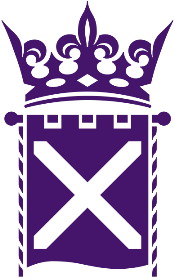 In Scotland, however, the unicameral parliament has adopted a crowned banner as its distinctive insignia. (For previous posts on prominent emblems of modern Scottish design, see the Clootie Dumpling and the Daisy Wheel). The crown expresses authority — ultimately the sovereign power of the monarchy — while the corded banner hanging from a pommelled pole displays the Saltire, Scotland’s national flag. While early versions of the emblem were in blue, it is now standard that the symbol be depicted in purple, long a colour associated with Scotland through the national florae of heather and thistle. (more…)
In Scotland, however, the unicameral parliament has adopted a crowned banner as its distinctive insignia. (For previous posts on prominent emblems of modern Scottish design, see the Clootie Dumpling and the Daisy Wheel). The crown expresses authority — ultimately the sovereign power of the monarchy — while the corded banner hanging from a pommelled pole displays the Saltire, Scotland’s national flag. While early versions of the emblem were in blue, it is now standard that the symbol be depicted in purple, long a colour associated with Scotland through the national florae of heather and thistle. (more…)
End of the Line for Rizzoli Bookshop
Another New York bookshop bites the dust
In New York, good things are only allowed to last a little while: eventually they must all be destroyed. The latest to add to the pile is the Rizzolli bookshop on West 57th Street, which has received notice that the landlords intend to demolish the 109-year-old structure in which the bookshop is housed.
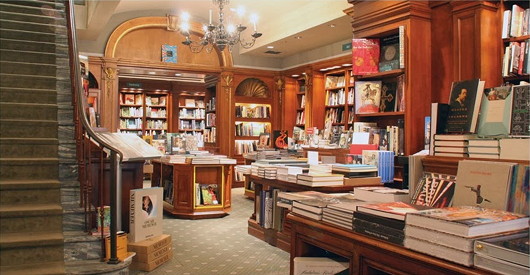
Rizzoli, publishers of some of the finest and most luxuriously printed books on the market, have not yet said whether they will be opening shop elsewhere.
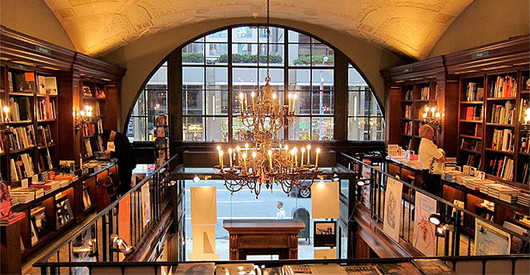
If so, it would be the second move for the shop, which opened in 1967 at 714 Fifth Avenue (below), just around the corner. A developer tried to tear that building down as well, but preservationists managed to have the façade, with its lalique glass, incorporated into the new tower. It’s now home to Henri Bendel.
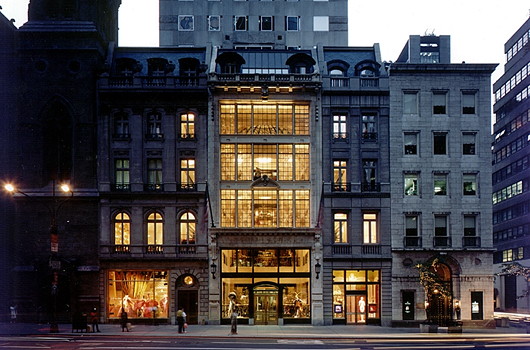
Other New York bookshops to close in recent years include the Librairie française, Coliseum Books, Gotham Book Mart, Urban Center Books, and further back more venerable institutions like Scribner’s and Brentano’s.
Top three photos: Mais Uma Pagina
A Bunny Rampant
The carto-heraldic creativity of MacDonald Gill
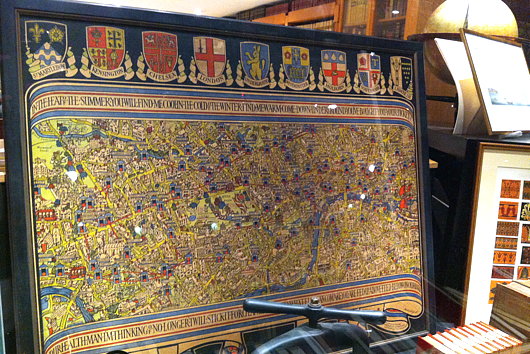
If anything, I am a lover of maps, and as a cartophile it’s a fine thing that I spend half my life in South Kensington. Here you will find two of the best antiquarian map merchants around: the Map House on Beauchamp Place and Robert Frew across from the Oratory and right next door to Orsini. Milling about in front of church after mass today I received a tip-off from a friend suggesting I have a look at the window of Robert Frew, as there was a London Underground map with coats of arms of mostly abolished boroughs.
“Sounds like the sort of thing MacDonald Gill would do,” I said, and sure enough upon investigating earlier tonight it is the work of that inventive designer (and brother of Eric Gill).
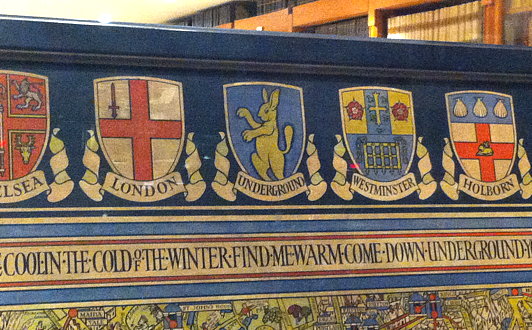
The most splendid and ridiculous aspect is that in the central place among the municipal heraldry was a putative coat of arms MacDonald Gill thought up for the Underground: a rabbit rampant. Indeed, given the twin characteristics of being speedy and digging the earth, the rabbit is a perfect animal avatar for the London Underground to adopt. Don’t go looking for this design anywhere in the rolls of Garter King of Arms, though: it’s merely the invention of the creative mind of master map-maker MacDonald Gill.
Search
Instagram: @andcusack
Click here for my Instagram photos.Most Recent Posts
- Burns Tower April 19, 2024
- Patrick in Parliament March 18, 2024
- Articles of Note: 13 March 2024 March 13, 2024
- Cambridge March 9, 2024
- Taken on Trust March 4, 2024
Most Recent Comments
Book Wishlist
Monthly Archives
Categories


